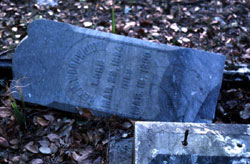What should I do and not do to maintain a historic cemetery?

There are a number of ways that historic burial sites and many types of gravemarkers can be protected from natural weathering and deterioration:
1. If dirt and biological growth must be removed from a marker or other funerary item, always use the gentlest method possible for cleaning -- preferably only clean water and a soft-bristled brush. High-pressure water spray, sandblasting, or the application of materials such as household bleach, muriatic acid and commercial stone cleaners will cause physical deterioration of stone and masonry items, and may pit and/or discolor marker surfaces. Wire-bristled brushes, sandpaper and other abrasive pads should not be used because they can scratch the finished surfaces of markers.
2. Removing vines and other plant growth from markers and other funerary materials will keep them dry and minimize the growth of lichens, mosses, mildew, etc. Remove vegetation from cracks and joints of masonry structures. Trim trees and shrubs at least 18 inches away from markers. However, take care not to damage or remove historical plantings.
3. Avoid using commercial stone cleaners, sealants or coatings on markers in an attempt to prevent deterioration or repel water. Some coatings can prevent the evaporation of moisture in stone and masonry, which will actually result in increased deterioration rather than protection of the object.
4. Herbicides and fertilizers that come in contact with markers can cause deterioration and discoloration of stone and masonry, and can corrode metal fences, plaques and statuary. Avoid using them near markers and tombs.
 5. Avoid mowing near gravestones and other funerary items so they will not be scraped or nicked by the machines.
5. Avoid mowing near gravestones and other funerary items so they will not be scraped or nicked by the machines.
6. Do not make a rubbing of a gravestone if it is in poor condition and may fracture from the pressure applied to its face. When making a rubbing, be sure that the marker is completely covered with paper and the rubbing medium will not leave any residue.
7. When cleaning up a neglected cemetery, do not discard stone fragments or other materials belonging to grave plots. These will be important for future restoration projects and for understanding and interpreting information from the burial site.
8. Repairs and emergency stabilization efforts must be "reversible" and done with proper materials and techniques. Consultation with a conservator familiar with the problems and restoration procedures used for cemeteries will assure that restoration efforts are completed in the proper manner. (If necessary, contact The American Institute for Conservation of Historic and Artistic Works, 1156 15th Street NW, Ste. 320, Washington, D.C. 20005, http://www.conservation-us.org/about-conservation/find-a-conservator#.VE6vCPnF9We for the organization's referral service and for a copy of Guidelines for Selecting a Conservator).
For detailed preservation/conservation information about the above, please consult the references listed in the annotated bibliography.

